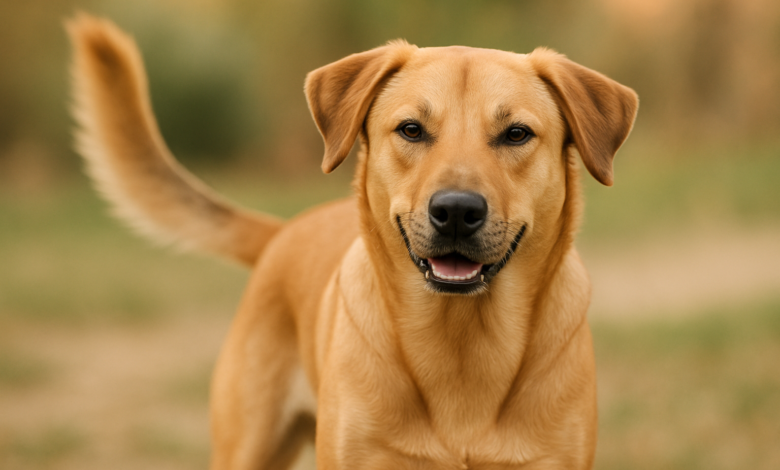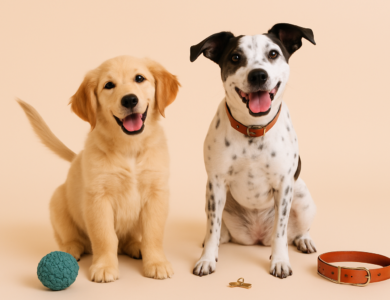We may earn a commission when you click on links across our website. This does not influence our opinions — learn more.
Myth Busted: Do Dogs Only Wag Their Tails When They’re Happy?

If you have a dog, chances are you’ve spent more time than you’d admit staring at that tail like it’s some kind of furry mood ring. And you wouldn’t be alone. Scientists — actual people with PhDs — have spent years doing the same thing, trying to decode what a tail wag really means. The spoiler? It is absolutely not as simple as “I’m happy.” A wagging tail can signal joy, anxiety, uncertainty, stress, and even the early stages of aggression. Learning to read those signals properly can help you keep everyone safer and deepen your bond with your dog.
What Tail Wagging Really Means
Tail wagging is a sophisticated form of communication, not a one-note sign of happiness. Think of it as a broadcast signal that says, “I’m emotionally switched on,” without telling you exactly how the dog feels. That emotional arousal can be positive, negative, or somewhere in between, and the meaning changes depending on the angle, speed, stiffness, and direction of the wag.
It is, in many ways, the canine version of a human smile. People smile when they are delighted, but also when they are nervous, uncomfortable, or trying to diffuse tension. Dogs do the same thing with their tails, and if we only see “friendly” every time they move, we risk missing what they are really saying.
The Science Behind Left vs Right Wags
The idea that tail wagging is more complex than it looks is not just opinion — it is backed by years of research. In 2013, scientists at the University of Trento in Italy published a study in Current Biology showing that dogs wag their tails asymmetrically, and that the direction of the wag links directly to emotional state.
When dogs feel positive — seeing their owner, greeting someone familiar — they tend to wag more to the right (from the dog’s perspective). Those good feelings are tied to the left side of the brain, which controls right-sided body movement. When they are anxious, unsure, or stressed, the right hemisphere takes over, and the tail shifts to the left.
In other words, your dog is sending emotional Morse code with that tail, and we are only just learning how to read it.
Other dogs, however, are already fluent. Follow-up research found that dogs watching another dog wag to the left became visibly tense and uneasy, as if they had just heard the word “vet.” Watching a right-sided wag had the opposite effect — they stayed calmer and more relaxed. Tail wagging, it turns out, is not just communication between dog and human, but a language dogs are using with each other all the time.
It’s Even More Nuanced Than We Thought
As if that were not complicated enough, a 2023 paper in Biology Letters reviewed more than 100 studies on tail wagging and concluded that direction is only one part of the story. Wag speed, tail height, stiffness, and the dog’s overall body language all play crucial roles in decoding the message.
A loose, low, sweeping wag in a relaxed dog generally signals friendliness and comfort. A high, tight, rapid wag from a stiff-bodied dog can mean high arousal that is anything but friendly. And a slow, uncertain wag often reflects insecurity or caution — your dog is still trying to decide how they feel about what is happening.
The takeaway is simple: not all wags are created equal. A wag can mean “Yay, you’re home,” “Back off, I don’t like this,” or “I’m really conflicted right now,” depending on how it is delivered.
High, Low, And Everything In Between
The height of the tail offers one of the clearest clues. A tail held high often indicates confidence, alertness, or dominance. When paired with a stiff body and hard stare, that same high tail can hint at potential aggression or a warning that the dog is not to be pushed.
A neutral, mid-level tail with an easy, rhythmic wag usually reflects comfort and openness, the sort of body language you see in a dog who is content and ready to interact. A low tail, particularly one tucked between the legs, signals fear, anxiety, or submission. If there is a small, tentative wag in that tucked position, the dog is more likely saying, “Please do not hurt me,” than “Let’s play.”
Wagging Speed And Intensity
Speed adds another layer. A fast wag simply means intense feelings, not always positive ones. A rigid, high-speed wag on a tense body can indicate a dog ready to react defensively. A quick wag on a loose, wiggly dog with soft eyes and an open mouth usually means excitement and genuine happiness.
Slow, hesitant wags often show uncertainty. The dog is still gathering information, still deciding whether a person, situation, or other animal feels safe. That is not the moment to rush in with hands, hugs, or squealing children.
What Trainers And Humans Often Get Wrong
Many modern trainers have started incorporating tail direction, height, and quality of movement into their behavior assessments. A dog who consistently wags more to the left when meeting new people, for example, may be more uncomfortable than they appear and might benefit from slower introductions and plenty of positive reinforcement.
Humans, however, are still catching up. A study out of Arizona State University tested people’s ability to interpret dog emotions from video clips. Participants often relied on the situation — such as a leash, a doorbell, or a vacuum cleaner — rather than the actual body language the dogs were displaying. In other words, we are still reading dogs like a book in the wrong language, assuming “excited” where the dog might actually be saying “overwhelmed” or “worried.”
Context Is Everything
This is why focusing on the tail alone is such a common mistake. To truly understand what a dog is feeling, you need to read the entire body. Are the ears pinned back or relaxed? Are the eyes soft or staring? Is the mouth open and loose, or tightly closed? Is the body wiggly or stiff?
A dog with a high, fast wag, hard eyes, tense muscles, and retracted ears may be on the edge of snapping, despite that tail movement. Another dog with a wide, sweeping wag, relaxed posture, soft eyes, and a slightly open mouth is far more likely to be genuinely friendly.
The situation matters, too. A dog wagging at the vet, tail low and body hunched, is not having a good time — even if that tail is technically moving.
The Happiest Signal Of All
There is one wag that is almost universally good news: the full-circle “helicopter tail” or “propeller wag.” This is when the tail rotates at the base, often dragging the entire back end of the dog into a delighted wiggle.
Most dogs reserve this for their favorite people and closest friends. You will see it when you come home after a trip, when a beloved family member walks through the door, or when a much-loved dog buddy appears at the park. If you get a helicopter tail, you are firmly in the “inner circle.”
Why The Wagging Tail Myth Is Dangerous
The idea that “wagging tail = friendly dog” is more than just inaccurate; it can be dangerous. Many bites happen because someone approached a dog assuming that tail movement meant it was safe to touch, hug, or crowd them.
Children are particularly vulnerable. They are often taught oversimplified rules like “If the tail is wagging, the dog likes you,” without learning the subtle differences between a relaxed wag and a stressed one. A child who rushes in to hug a nervous, stiff, left-wagging dog may be stepping straight into a situation the dog feels forced to correct with teeth.
The Tail End Of It All
A wagging tail is communication, not a guarantee of friendliness. Dogs wag when they are joyful, but also when they are nervous, scared, uncertain, or preparing to defend themselves. The real skill lies in watching how they wag — left or right, high or low, loose or stiff, fast or slow — and combining that information with the rest of their body language.
Do that, and you are no longer just a pet owner — you are edging closer to a genuine canine translator. And the next time your dog greets you with that big helicopter tail and full-body shimmy, you will know it is not just noise in the background. It is their way of saying, as clearly as they can, “You are my favorite person in the world… even if I do have serious concerns about your choice of shoes.”



